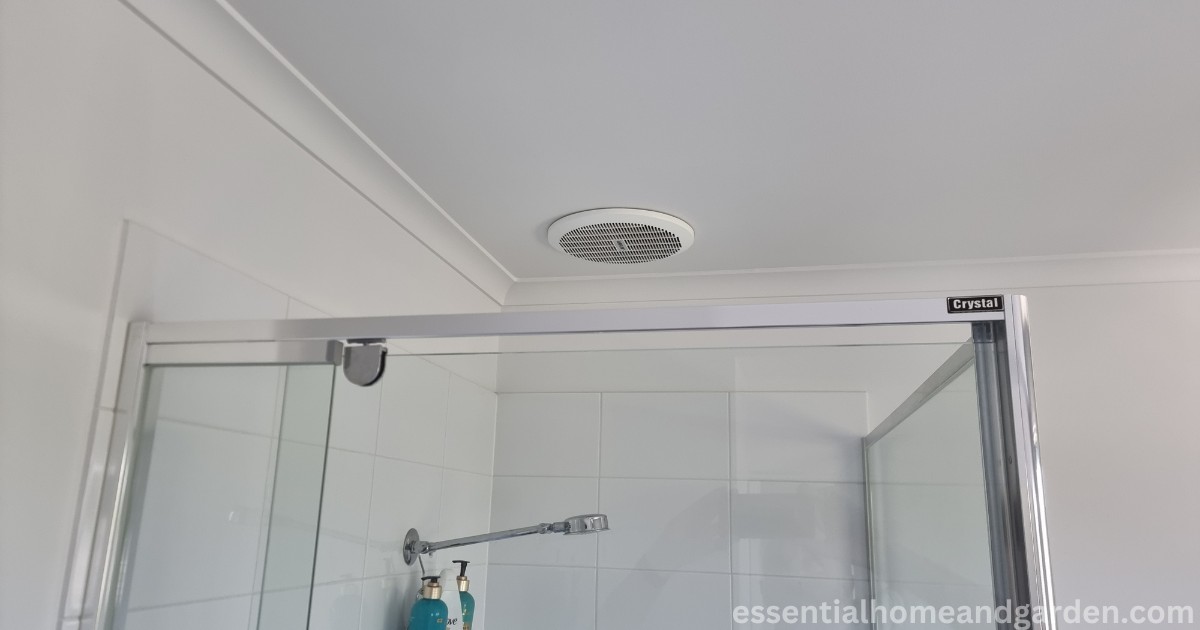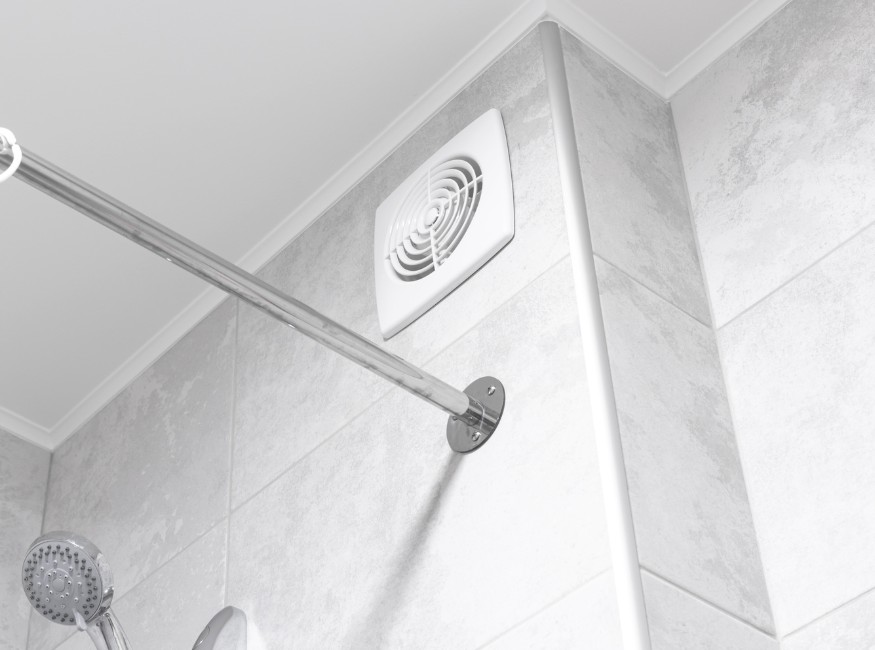The size of an exhaust fan installed in a bathroom is one of the most important factors to consider when it comes to ensuring maximum efficiency and effectiveness.
It is essential that the capacity of the fan matches that of the room; otherwise, air will not circulate as efficiently as desired. In this article, we will discuss how to determine the right size for your bathroom exhaust fan, what factors should be taken into consideration when selecting an exhaust fan size, tips and tricks for choosing a suitable model, common mistakes people make when selecting a fan size and more.
Determining the appropriate exhaust fan size for your bathroom
When choosing a bathroom exhaust fan, you’ll want to select a bathroom fan that is rated for at least 1 CFM per square foot of bathroom space. This means, if your bathroom is 50 square feet, you’ll need a fan that is rated for at least 50 CFM. It is always better to choose a fan with a slightly higher CFM rating than you need as it will ensure your bathroom is well ventilated.
It’s also important to note that the CFM rating of a bathroom fan is not the only factor to consider when choosing the right fan for your bathroom. Other factors such as noise level, energy efficiency, and installation ease also play an important role.
Basic Bathroom Fan Size Formula
For bathrooms that are less than 100 sq ft and have a ceiling height of 8 feet or less, just follow this simple rule: select a fan with one CFM for every square foot of floor area. For example, if your bathroom is 80 square feet, you will need to choose an exhaust fan with a CFM rating of 80.
Larger Bathrooms or rooms with High Ceilings – Calculator
For bathrooms that are larger than 100 sq ft and/or have a ceiling height of over 8 feet then you will need to adjust how you calculate the required CFM of the bathroom exhaust fan.
There are two options to do this.
The first option is to use the handy calculator below. Simply enter the rooms square foot size and the ceiling height and choose a fan that is slightly larger than the CRM measurement calculated.
The second method is to do the calculation manually:
- Calculate the cubic footage of your bathroom by multiplying the square footage by the ceiling height. For example, if your bathroom is 80 square feet with a ceiling height of 10 feet, you would have 800 cubic feet.
- Divide the cubic footage by the number of minutes in an hour. In this case, 800 divided by 60 equals 13.33. Round this number up to the nearest whole number, in this case 14.
- Multiply the previous number by the desired number of air exchanges per hour. The standard recommendation is 8 air exchanges per hour, so 14 multiplied by 8 equals 112 CFM.
Exhaust Fan Size Chart – CFM to Room Size
| Bathroom Size (Sq Ft): | CFM (Under 8 Foot Ceilings) | CFM (8 foot Ceilings) | CFM (10 foot Ceilings) |
|---|---|---|---|
| 20 | 20 CFM | 22 CFM | 27 CFM |
| 30 | 30 CFM | 32 CFM | 40 CFM |
| 40 | 40 CFM | 43 CFM | 54 CFM |
| 50 | 50 CFM | 54 CFM | 67 CFM |
| 60 | 60 CFM | 64 CFM | 80 CFM |
| 70 | 70 CFM | 75 CFM | 94 CFM |
| 80 | 80 CFM | 86 CFM | 107 CFM |
| 90 | 90 CFM | 96 CFM | 120 CFM |
| 100 | 100 CFM | 107 CFM | 134 CFM |
| 120 | 120 CFM | 128 CFM | 160 CFM |
| 140 | 140 CFM | 150 CFM | 187 CFM |
| 150 | 150 CFM | 160 CFM | 200 CFM |
| 160 | 160 CFM | 171 CFM | 214 CFM |
| 180 | 180 CFM | 192 CFM | 240 CFM |
You can print the chart above by clicking the “Print” button.
The Importance of Matching the Bathrooms Capacity with the Fan Capacity
The installation of the right fan for the size of your bathroom is essential for proper ventilation. The capacity of the fan must match the capacity of your bathroom to ensure it does its job efficiently and effectively. It may be tempting to purchase a smaller fan in order to save money, but this could actually end up costing you more in the long run.
If the fan is too small, it won’t be able to move enough air to properly ventilate the bathroom. This can lead to condensation and moisture buildup on walls and ceilings, leading to water damage, mold growth, and expensive repairs.
On the other hand, having a fan that is too large for your bathroom can also be a problem. Over-ventilating can result in too much air movement, making the room uncomfortably cold and drafty. It can also lead to higher energy costs since more air is being moved than necessary. A larger than required bathroom fan will also result in more noise, and exhaust fans can often be heard in adjacent rooms – so matching the fan CFM rating to your room size is important.
The Types Of Bathroom Exhaust Fans
When it comes to bathroom exhaust fans, there are a few different types to choose from. Each one has its own set of pros and cons, so it’s important to understand the differences and select the right one for your bathroom.
The most popular types of bathroom exhaust fans are:
Ceiling-Mounted Fans
Ceiling-mounted fans are the most common type of bathroom exhaust fans. They are mounted on the ceiling and typically run on a timer or are controlled by a switch. These fans are great for removing moisture and odors from the bathroom as they sit at the highest point of the room.
Wall-Mounted Fans
Wall-mounted fans are similar to ceiling-mounted fans, but they are mounted on the wall instead of the ceiling. These fans are a great option for bathrooms with limited ceiling space, but they can also be louder than ceiling-mounted fans. However, they can be more difficult to install and due to their location being lower than the ceiling, may not be as effective at removing moisture and odors.
Inline Fans
In-line fans are installed in a remote location, usually the ductwork of your attic, rather than directly on the ceiling or wall. A duct is run to the roof or wall of the bathroom and a grill is placed over the opening. They are typically the most powerful type of bathroom exhaust fan, but they can be difficult to install and may require professional help. They’re a great option for larger bathrooms or those with high moisture levels.
Understanding Bathroom Exhaust Fan Size – CFM Explained
One of the most important factors to consider when choosing a bathroom exhaust fan is the size of the fan, specifically, how much air it can move per minute. This measurement is known as cubic feet per minute (CFM) and it’s essential to understand how it affects the performance of your bathroom exhaust fan.
CFM is the standard measurement used to determine the airflow of a bathroom fan. It tells you how much air the fan can move in one minute. The higher the CFM rating, the more powerful the fan is.
Does a Bathroom Exhaust Fan Need Ventilation or a Fan Duct?
Yes, your bathroom exhaust fan does need ventilation to the outside. This isn’t just due to the fact that you really dont want moisture entering your attic or wall space, but also many areas have building codes that exhaust fans require outside venting.
The fan should be connected to ducting that is designed and sized specifically for the particular model and CFM rating of fan being used. It is important to select a vent system that is large enough to accommodate the volume of air being moved by the fan at its highest setting.
Does a Separate Toilet Or Shower Room Need a Ventilation Fan?
When it comes to bathroom ventilation, it’s important to consider all the spaces within the room, including any enclosed areas like a toilet or shower stall. In these cases, it may be beneficial to install a separate exhaust fan to effectively remove moisture and odors from these areas.
For smaller enclosed spaces, such as a small shower stall, a fan with a CFM rating of 50 may be sufficient. However, if the space is larger, it’s important to determine the appropriate CFM rating based on the room’s size. Remember, the fan can only effectively ventilate the area if there is adequate airflow.
It’s also crucial to keep in mind that if the door to the enclosed area is closed and there is no gap at the bottom, the fan may struggle to perform its job. To prevent this, you can leave the door slightly ajar when using the toilet or shower or consider installing a louvered door that allows airflow. Another solution is to install an automatic door sweep or door shoe gasket to ensure that the gap is at least 5/8 inch which will allow enough makeup air to come in.


